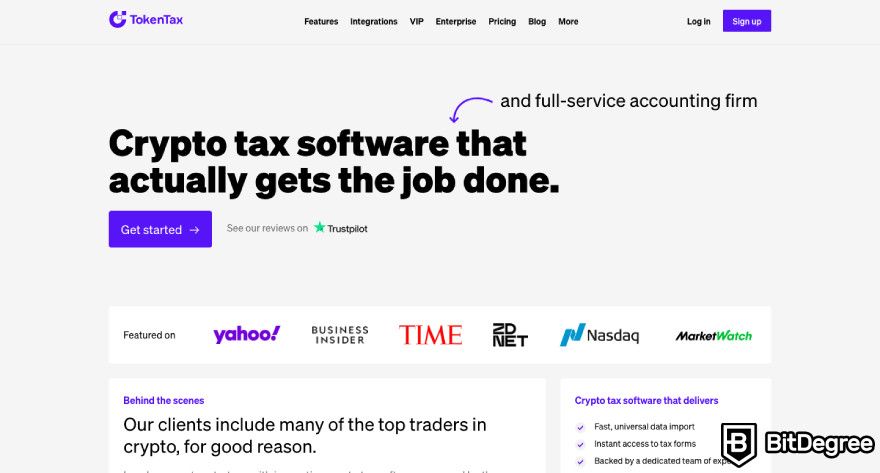Key Takeaways
- Crypto tax-loss harvesting allows you to sell your crypto at a loss to offset your capital gains and lower your tax bill;
- You can make use of the Wash Sale loophole and repurchase your crypto within 30 days of selling it so your portfolio remains unaffected;
- If your capital losses exceed your capital gains, you can roll them over into the next year or use them to deduct up to $3000 from your ordinary income.
Stop overpaying - start transferring money with Ogvio. Sign up, invite friends & grab Rewards now! 🎁
The saying “no pain, no gain” is a familiar platitude among investors – capital losses are such a fact of life that, instead of mourning them, you might as well find a way to leverage them to your advantage. That’s exactly what crypto tax-loss harvesting is all about: taking the sting out of unsuccessful investment decisions by recouping your money through a tax deduction. And when it comes to crypto, tax-loss harvesting could turn out to be an even more valuable tool!
After two years of relative chaos and uncertainty, the cryptocurrency market seems to have finally found its way back to the bull track. Nevertheless, a wise crypto investor should always look out for a storm and be ready to act.
If you’re eager to learn how to turn your proverbial lemons into lemonade by harvesting your tax losses with crypto, look no further! With the help of this article, as long as you own some crypto coins, you can strategically sell and buy them to lower your tax bill. If you haven’t gotten your hands on some coins yet, you can always buy them on major crypto exchanges such as Binance, Bybit, or Kraken.

Did you know?
Subscribe - We publish new crypto explainer videos every week!
What is a Crypto Airdrop & How to Get FREE Coins? (Animated)


Table of Contents
- 1. What Is Crypto Tax-Loss Harvesting?
- 1.1. Is Crypto Tax-Loss Harvesting Legal?
- 1.2. The Wash Sale Loophole
- 2. Who Can Benefit From Tax-Loss Harvesting?
- 3. How Does Crypto Tax-Loss Harvesting Work?
- 4. Can You Tax-Loss Harvest NFTs?
- 5. Is Tax-Loss Harvesting With Crypto Worth It?
- 5.1. Benefits
- 5.2. Risks
- 6. How to Get Started With Crypto Tax-Loss Harvesting?
- 7. Crypto Tax-Loss Harvesting Software
- 7.1. TokenTax
- 7.2. Recap
- 7.3. CoinTracker
- 7.4. Blockpit
- 7.5. ZenLedger
- 8. Conclusions
What Is Crypto Tax-Loss Harvesting?
If you’ve never heard the words “crypto tax-loss harvesting” before, brace yourself – you’re in for a ride!
Latest Deal Active Right Now:In traditional finance, tax-loss harvesting is a strategy used by investors to avoid paying higher taxes. When it comes to any kind of investment, you only have to pay taxes for realized capital gains – the profit you made by selling an asset for a higher price than you bought it.
However, the higher your capital gains, the higher taxes you have to pay for them. That’s where tax-loss harvesting comes into action: by deliberately selling an asset during the dip when its price is lower than what you originally paid for it, the resulting capital loss cancels out the capital gains you’ve made, and the difference gets deducted from your taxes.
The good news is that if you’ve got a grasp on tax-loss harvesting in general terms, you already know what crypto tax-loss harvesting is! Still, let me illustrate with a case in point.
Example
Let’s say Christina bought 1 BTC for $42,000 and 1 ETH for $1000. Later, the price of BTC fell to $18,000 while the price of ETH went up to $3000. Christina wants to realize her gains on ETH so she sells it at $3000.
This means she now has $2000 in capital gains from that 1 ETH she’s sold. Without tax-loss harvesting, she would now owe taxes on those $2000.

Sounds like a raw deal? Christina thinks so, too – that’s why she decides to tax-loss harvest her crypto to lower her bills. She sells her 1 BTC for the current market price of $18,000, incurring a capital loss of $24,000.
She can now offset this capital loss against the capital gain from ETH (with a lot left to spare – more on this later). As a result, her capital gains get wiped out, meaning she won’t have to pay taxes on them.
Is Crypto Tax-Loss Harvesting Legal?
If this seems a bit too good to be true, rest assured – crypto tax-loss harvesting is perfectly legal! As per the IRS (Internal Revenue Service) and corresponding authorities in most other countries, it’s a legitimate tax avoidance strategy and doesn’t fall under tax evasion. It’s been widely employed by a lot of investors in traditional finance too, not just with cryptocurrency.
As long as you file your taxes correctly, you have nothing to worry about. Not only is tax-loss harvesting with crypto allowed, but it even has an edge over harvesting losses with other assets due to a certain legislative loophole.
The Wash Sale Loophole
Since investors are known to be an enterprising bunch, regulatory authorities have to stay on their toes and keep plugging various legislative gaps to prevent overeager investors from exploiting the market, inadvertently or not. One such gap is particularly relevant to crypto tax-loss harvesting: the Wash Sale loophole.
The Wash Sale rule is a legislation meant to obstruct an obvious scheme investors could be tempted to carry out: if all you need to neutralize your capital gain taxes is to sell an asset at a loss before the end of the tax year, what’s stopping you from simply buying that asset again immediately afterwards so that your portfolio remains unchanged?
To that end, the IRS has implemented the Wash Sale rule that prevents taxpayers from deducting losses on securities sold at a loss and bought back within 30 days before or after the sale.

This law isn’t unique to the USA: the equivalent authority in the United Kingdom, HMRC, enforces the same rule. Over there, it goes under the name of “Bread and Breakfast rule”.
So, what’s that loophole again, you might ask?
Basically, due to cryptocurrency still being somewhat of a grey area in the US law, it’s not subject to the Wash Sale rule, at least for now. There’s a brewing debate over the legal status of crypto.[1] The U.S. Securities and Exchange Commission classifies all cryptocurrencies as securities, except for Bitcoin. The IRS, on the other hand, maintains that crypto is property.
For all intents and purposes, this means you’re free to sell your crypto at a loss and buy it back within the 30-day before-or-after window. That way, you can still retain your crypto while lowering its cost basis, and the following year’s capital gains will now be counted from this new starting point.
Who Can Benefit From Tax-Loss Harvesting?
While I’ve hopefully managed to paint an enticing picture of crypto tax-loss harvesting so far, don’t get too excited yet – none of this could be relevant for you if you’re not the right audience for tax-loss harvesting in general.
If you live in the US, it’s possible that you’re already exempt from paying taxes on long-term capital gains. This exemption applies to the following annual income brackets:
- up to $44,625 (single/married and filing separately)
- up to $89,250 (married and filing jointly)
- up to $59,750 (head of household)
If you fall under any of these groups, the truth is that you don’t really have much to gain from crypto tax-loss harvesting, at least in practice.
If, on the other hand, your annual income exceeds those thresholds – or perhaps if you’re still interested in learning more about crypto tax-loss harvesting purely for the sake of curiosity – carry on!
Let’s take a closer look.
How Does Crypto Tax-Loss Harvesting Work?
While the basics of crypto tax-loss harvesting might not be rocket science, there are still quite a few intricacies to comb through. What’s more, missing even one piece of the puzzle can make the whole operation fall through. With stuff like taxes, the stakes are simply too high to be half-hearted about it. So read these following sections carefully!
Timing
One crucial component of a successful crypto tax-loss harvesting strategy is planning ahead. You have to realize your losses by the end of the tax year (before December 31st in the US and April 15th in the UK). Any losses you realize after those dates will count towards the next year.
Make sure to start early, too – don’t leave it until the last minute!

That said, while it’s imperative to keep track of this final deadline, the end of the tax year isn’t the only time you can harvest your losses. Crypto investors often strategically dabble in tax-loss harvesting throughout the year to take advantage of market dips, especially during the bear market.
Cost Basis Methods
Another crucial factor that could make or break your crypto tax-loss harvesting efforts is picking the right cost basis method when calculating your crypto gains and losses.
In crypto, the cost basis is the sum of the original price you paid for a coin or token and their transaction fees.

The cost basis method (sometimes called the accounting method) lets you determine the order in which to sell your crypto coins if you’ve bought them several times at different price points.
The three most popular cost basis methods in the US are:
- FIFO (First In First Out): The first crypto batch you’ve bought is the first one you sell.
- LIFO (Last In First Out): The reverse of FIFO.
- HIFO (Highest In First Out): The coins with the highest cost basis (at the point of purchase) are the ones you sell first.
In the US, FIFO is often the default choice for crypto tax-loss harvesting, especially when the goal is to play the long game and exploit the market dip – in this case, the coins you bought first will be the ones you paid the most for.
Meanwhile, some countries like Australia and the UK use the cost of purchase as the default cost basis method.
Speaking of the long game – gains from crypto coins sold after holding them for a year or more are taxed at a lower rate, which is another good reason to stick to the FIFO method as a safe default choice.
Limitations
If you’ve suffered a losing streak, you’ll be glad to hear that none of it needs to go completely to waste – in the US, there’s no cap on how much of your losses you’re allowed to harvest, crypto or otherwise.
Even if your realized capital losses completely cover your gains or exceed them, the surplus gets rolled over into the next year. There’s no expiration date to speak of.
For those in the US, there’s one more potential benefit to capitalize on: you can use surplus losses to deduct up to $3,000 of your regular annual income!

If you’re married but filing separately, the income deduction ceiling is $1,500.
Aside from these considerations, you should also bear in mind that, as I said, long-term and short-term gains are held to a different standard and taxed accordingly. Crypto holdings that are sold within 12 months of purchase have a tax rate up to 17% lower than those you’ve held on to for more than 12 months.
The IRS recommends that you offset gains and losses of the same type against each other – meaning that if you’ve incurred short-term losses, you should first use them to offset short-term gains and vice versa.
Can You Tax-Loss Harvest NFTs?
What about cryptocurrency’s non-fungible sibling, then? Do the crypto tax-loss harvesting rules apply to NFTs, as well?
Thanks to their languishing status in the current crypto market landscape, many NFT owners are now wondering if they should pull the plug. If you’re one of them – you can do precisely that if you’re so inclined! NFTs are legally recognized as a type of crypto asset, so they’re subject to the same taxation laws.

However, NFTs’ unique properties and uncertain place in the ecosystem might add some additional hoops to jump through, such as the difficulty of estimating their value or finding potential buyers.
Is Tax-Loss Harvesting With Crypto Worth It?
You’ve seen the big picture – now it’s time to whip out the measuring scales. Is there a catch to crypto tax-loss harvesting? How do the pros and cons add up?
Benefits
The number one incentive to tax-loss harvest your crypto is, of course, lower taxes. As I’ve outlined above, leveraging your losses that way can offset not only your capital gains taxes but a portion of your annual income tax as well.
From this angle, it seems like there’s no good reason to sit on your losses and wait for the tide to turn, only to end up having to pay higher taxes on your gains. This is especially relevant for those in the higher income brackets since they’re liable to pay higher taxes as well.

Even if your income level exempts you from capital gains taxes, partaking in tax-loss harvesting every now and again can be an excellent way to keep your financial faculties from getting rusty. Being an investment whiz is like playing chess – even if you’re not making a move at the moment, you should always be calculating your next one!
Let’s be clear, however – there are always some perils lurking around the corner, too.
Risks
One of the most pressing worries, at least in the US, is the looming closure of the Wash Sale loophole. Let’s face it – being the new player in the finance sector has allowed cryptocurrency to fall through the cracks where certain regulations are concerned, much to the gratitude of investors eager to probe this untapped frontier.
But this won’t last forever. In the US, the Biden administration has already set their eyes on closing the loophole, which would make crypto tax-loss harvesting wash sales illegal, just like with other assets.

It’s not just the regulatory bodies that might put a spoke in your wheel, though – you’re more likely to accidentally do that yourself! If you give in to the temptation of a crypto tax-loss harvesting wash sale and buy your coins back, the reduced cost basis could weigh you down with even higher capital gains taxes in the long run.
Lastly, don’t forget to factor in the general high volatility of the crypto market[2] – it can definitely make it more challenging to determine the optimal time to dispose of your crypto holdings.
How to Get Started With Crypto Tax-Loss Harvesting?
With this precautionary advice out of the way – if you still want to try your hand at tax-loss harvesting with crypto, I have a few tips.
Here’s a simple checklist you can follow:
Step 1: Review the current crypto market situation and identify coins whose value has dropped since you last bought them.
Step 2: Take a look at the crypto market predictions for the near future – is the situation expected to change drastically?
Step 3: Analyze the history of your crypto portfolio – does it contain the coins in question?
Step 4: Calculate the capital losses you could claim if you sold those coins at their current market price.

Step 5: Check if those capital losses would be enough to offset your capital gains and/or some of your annual income.
Step 6: Decide which cost basis method you’d like to use.
Step 7: Sell your coins on an exchange platform like Binance or Kraken.
Step 8: File your taxes at the end of the year and claim your capital losses.
As you can see, the logistics themselves are much less complicated than the strategic thinking homework you’ll have to do beforehand! Take your time and examine your options from every angle.
Crypto Tax-Loss Harvesting Software
These days, if it feels like there should be an app for it – there probably is! Crypto tax-loss harvesting is no exception. There’s no longer any need to manually pore over the history of your crypto transactions while trying to crunch the numbers in your head.
In 2024, you’re spoilt for choice regarding tax-loss harvesting software. Let’s check out some of the top contenders.

Did you know?
Subscribe - We publish new crypto explainer videos every week!
Layer 2 Scaling Solutions Explained With Animations


TokenTax

Founded in 2017, this app is a full-fledged crypto tax calculator with a host of general accounting functionalities as well. It's supported in the US, the UK and Canada.
TokenTax boasts an intuitive interface and features like automatic API imports, CVS uploads, and NFT support. You can easily generate different types of tax reports and choose between FIFO, HIFO, or LIFO cost basis methods.
The pricing has several tiers, starting from $65/year. Sadly, this app has no free trial option.
Recap

Recap is a privacy-focused crypto tax app aimed at UK investors. It allows you to track your whole portfolio and accounts in one place. You can see your transaction history, analyze your performance, optimize future investments, and generate automatic reports in line with HMRC guidelines.
Recap has integrations with major crypto exchanges like Binance and Kraken. It comes with a free plan that covers all the basic needs of amateur investors, including unlimited integrations, mining and staking, and portfolio tracking. More prolific traders can opt for the Basic ($99/year) plan that includes up to 5,000 transactions or the Pro ($179/year) plan with no transaction limit.
Recap is available for MacOS, Windows and Linux.
CoinTracker
![]()
CoinTracker is another popular crypto-tracking tool with a user-friendly interface. It supports over 300 exchanges (including the most popular ones like Binance and Bybit) and a whopping 8,000 cryptocurrencies, as well as TurboTax and TaxAct platforms for e-filing in the US. It features automated DeFi detection and syncs all your crypto activity across different platforms.
The free version only includes tax summary and portfolio value, while Base ($59/year), Prime ($199/year), and Ultra ($599/year) plans come with extra capabilities like tax-loss harvesting and tax lots breakdown.
Blockpit

Blockpit is an Austria- and Germany-based company specializing in crypto-tracking solutions for private investors. Part of the “Big Four Accounting Firms”, Blockpit has been shaping European tax policies for over six years. It’s currently supported in the USA, Germany, the UK, Austria, France, Spain, Netherlands, Switzerland, Belgium, and Italy (coming soon).
Blockpit offers over 250,000 integrations – no matter how obscure your blockchain, exchange platform or wallet of choice is, chances are it’s available! The app also comes with a plethora of advanced DeFi, staking, and mining taxation features. You can monitor your portfolio on the dashboard and get real-time insights, generate country-specific tax reports, and even get pre-filled tax forms.
Blockpit has four different annual plans based on the number of transactions per tax year: Lite ($49; up to 50 transactions), Basic ($109; up to 1,000 transactions), Pro ($269; up to 25,000 transactions), and Unlimited ($639; up to 500,000 transactions).

- Secure and reliable
- Accepts fiat currencies
- Lots of trading options
- Reputable exchange
- Accepts fiat currencies
- Offers various trading options

- Huge trading variety
- Regulation-compliant around the globe
- Fair trading fees
- Beginner-friendly
- A wide array of features
- Vast number of different crypto coins & tokens

- Beginner-friendly
- Secure
- Decent trading and withdrawal fees
- Crypto.com Visa Card
- Automated tools & bots
- Ecosystem synergy with CRO
ZenLedger

This app is tailored towards the US tax system but has an option for providing generic reports for a number of other countries, too. It lets you calculate your taxes using FIFO, LIFO or HIFO cost basis method. It’s an extensive crypto tax calculator that gives you a bird’s eye view of all your transaction history and capital gains or losses so you can make informed decisions.
ZenLedger comes in three price tier plans – Silver ($49/year; up to 100 transactions), Gold ($199/year; up to 5,000 transactions) and Platinum ($399/year; up to 15,000 transactions), all of which include the tax-loss harvesting tool.
Conclusions
As you can see, crypto tax-loss harvesting is not some nefarious trickery – quite the contrary, it can serve as a life-changing tool in your investment strategy box if you master it!
Let’s have a little recap: crypto tax-loss harvesting involves selling your crypto for a lower price than you originally bought it, thus incurring a capital loss you can use to offset your capital gains and reduce your taxes. The surplus deduction can be rolled over to the next tax year or used to offset up to $3000 of your annual income.
Let me hammer in one crucial point again: as of now, crypto tax-loss harvesting is still excluded from the Wash Sale rule in the US (or the corresponding Bed and Breakfast rule in the UK), meaning you can simply buy the same or “substantially identical” crypto asset again if you didn’t actually want to get rid of it, only to lower your cost basis.
If you’re confident that crypto tax-loss harvesting is right for you, feel free to pop over to your exchange platform (if you haven’t signed up to one yet, I recommend Binance, Bybit or Kraken), weigh your transactions, and consider using crypto tax-loss harvesting software to save yourself some time.
The content published on this website is not aimed to give any kind of financial, investment, trading, or any other form of advice. BitDegree.org does not endorse or suggest you to buy, sell or hold any kind of cryptocurrency. Before making financial investment decisions, do consult your financial advisor.
Scientific References
1. L. W. Cong, W. Landsman, E. Maydew, et al.: ‘Tax-Loss Harvesting with Cryptocurrencies’;
2. H. Gupta, R. Chaudhary: ‘An Empirical Study of Volatility in Cryptocurrency Market’.









